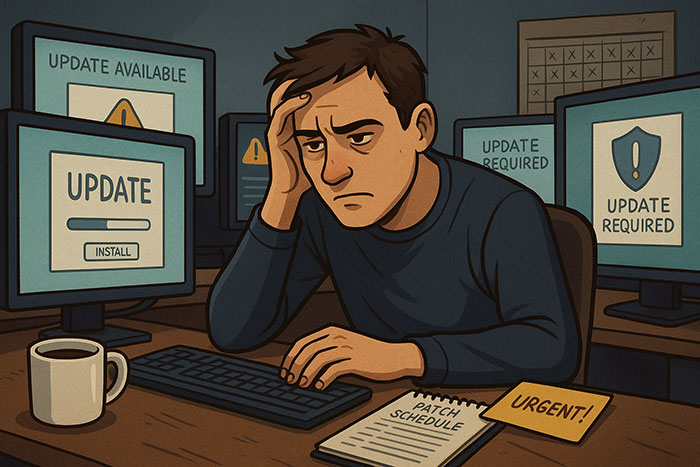If you’re working in IT, you probably know the feeling: another update notification pops up just as you’re wrapping up a long day, and all you can think is, “Didn’t we just patch that?” You’re not alone. Patch fatigue is a growing issue across IT teams—especially as security threats accelerate and software providers push more frequent updates.
So, what can you do when the volume of patches starts to feel like a full-time job? In this article, we’ll break down what’s driving patch fatigue, how it affects IT teams, and most importantly, practical ways to stay on top of patches without burning out.
What Is Patch Fatigue, and Why Is It Getting Worse?
Patch fatigue refers to the burnout that results from constantly monitoring, testing, and deploying patches across multiple systems. Whether it’s for operating systems, third-party apps, or infrastructure tools, the demands are relentless.
What’s changed recently?
- Security threats are more aggressive and frequent. Many patches now address zero-day vulnerabilities that require fast action.
- Software vendors release updates faster. Agile development cycles mean updates come weekly—or even daily.
- Hybrid and cloud environments complicate deployment. With more infrastructure spread across different platforms, patching is no longer a one-size-fits-all process.
- Regulatory pressures are rising. In industries such as finance or healthcare, staying compliant requires a rapid response to security updates.
All of this adds up to a situation where IT pros are constantly on edge, knowing a missed patch could mean a major security incident.
The Toll It Takes on IT Teams
It’s easy to think of patching as just another task on the to-do list. But over time, the grind wears down even the most seasoned professionals.
- Disrupted workflows: Emergency patches often force IT teams to drop everything and react immediately.
- Overtime burnout: Patching after hours or on weekends to avoid downtime becomes the norm.
- Mental fatigue: Constant vigilance creates a culture of stress and fear, especially in environments where downtime is not tolerated.
- Team morale: When every day feels reactive, it’s hard to find time for proactive work that improves systems.
The result? Slower responses, skipped steps, and sometimes even risky behavior, like delaying critical patches to keep pace with the workload.
Strategies to Combat Patch Fatigue
Here’s the good news: you don’t have to be stuck in a reactive loop. Below are some strategies that can help you keep systems secure without sacrificing your sanity.
1. Implement a Tiered Patch Schedule
Not every patch needs to be installed immediately. Create a patch priority matrix:
- Tier 1: Emergency (zero-days, active exploits)
- Tier 2: High (security-related but not being exploited)
- Tier 3: Routine (feature updates, bug fixes)
Automate what you can and reserve human review for Tier 1 items. This helps reduce cognitive load and allows the team to focus on what’s truly urgent.
2. Leverage Patch Management Tools
Invest in centralized tools like Microsoft SCCM, Ivanti, or Automox to streamline patch deployment across your environment. Many of these platforms allow for:
- Automated discovery of unpatched systems
- Pre-scheduling patches based on severity
- Real-time reporting and compliance tracking
Automation doesn’t mean you set it and forget it—but it can drastically reduce the manual labor involved.
3. Establish a Patch Cadence
Create consistency. For example:
- Emergency patches: Within 24 hours
- High-priority patches: Weekly patch window
- Routine patches: Monthly maintenance cycle
Let stakeholders know the patching cadence, so teams aren’t surprised by downtime or outages. Predictability is key to reducing stress.
4. Use a Staging Environment
Never patch production first. Test patches in a staging or QA environment that mimics your live setup. This helps:
- Identify software conflicts early
- Reduce rollback incidents
- Build team confidence in patching procedures
It takes a bit of setup time, but it pays off in reduced rework and crisis management.
5. Rotate Responsibilities
If one person on your team is responsible for all patches, burnout is inevitable. Create a rotating patch duty schedule so that responsibility is shared across the team.
This also serves as a cross-training opportunity and prevents single points of failure.
6. Communicate the Business Impact
Ensure leadership understands the importance of timely patching. Use simple, non-technical language:
- “This patch closes a security hole that could give attackers access to customer data.”
- “If we skip this update, our vendor will no longer support us.”
When leadership sees patching as risk reduction, not just maintenance, it’s easier to get the time and resources you need.
7. Celebrate Successes and Lessons Learned
Patch management is a thankless job—but it doesn’t have to be.
- Celebrate when patch cycles go smoothly.
- Share lessons learned when something doesn’t.
- Treat patching like an evolving skill, not just a checklist.
Recognizing wins (and misses) builds team culture and helps everyone learn together.
Beat Patch Fatigue
Patch fatigue is real—but it’s not unbeatable. By building better processes, utilizing the right tools, and fostering a culture that values patch management, your IT team can stay secure and remain productive.
It’s okay to be tired of patching. Just don’t let that fatigue turn into risk. With the right approach, patching can become a manageable part of your routine—not an emergency waiting to happen.




